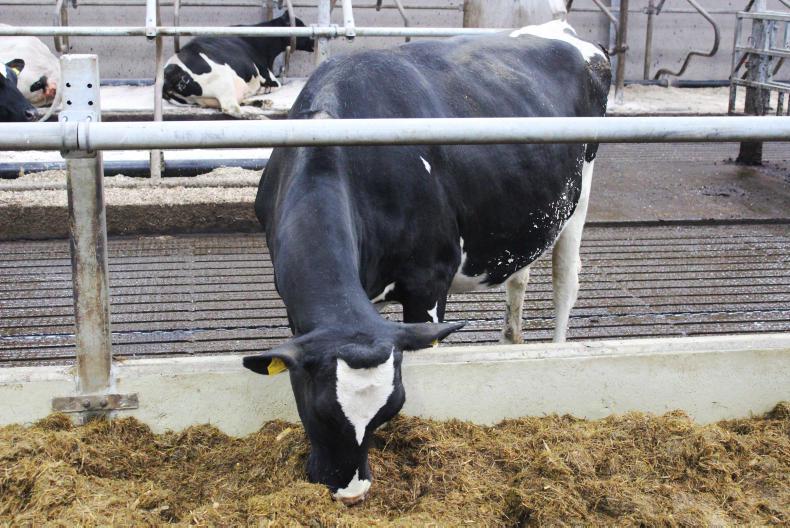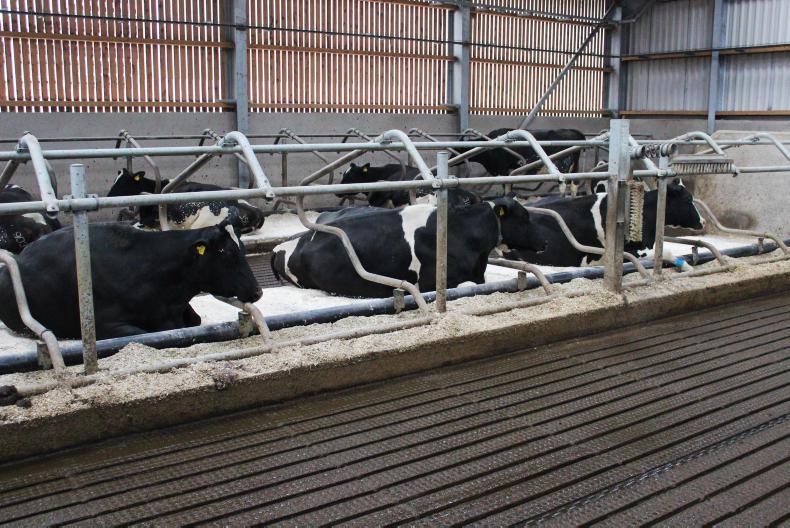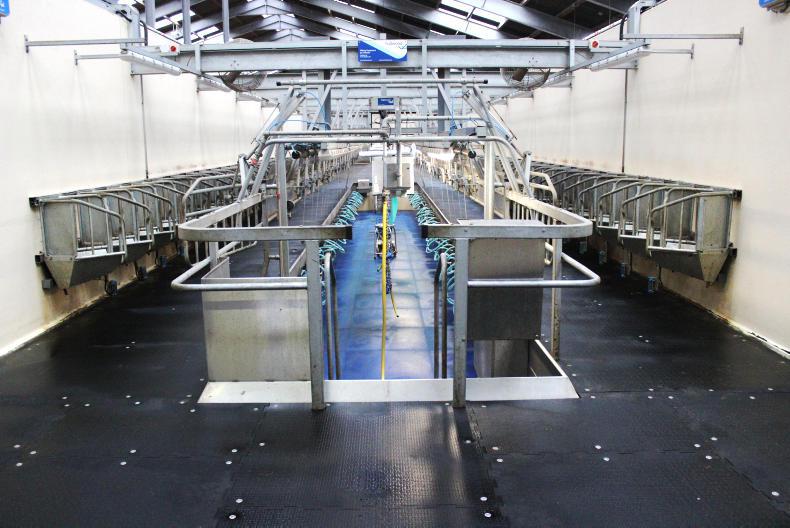Up north, the Future herd at the CAFRE centre in Greenmount is hitting production targets, three years after opening a large investment in facilities costing £2.6m and increasing herd size.
There are now over 200 cows milking, producing over 700kg of milk solids per cow.
It’s excellent production. It takes good management to deliver over 9,300l per cow or 700kg of milk solids per cow.
There is a lot of talk about high milk recording results, but to deliver this volume per cow takes excellent forage management and herd health management from genetically high producing cows.
In this herd, calving starts in late August, with two thirds of the herd calved by Christmas.
The remainder of the herd calves from January through to May.

The Future Herd at CAFRE, Greenmount.
Cows go to grass once settled in-calf in spring, by day in March, and day and night by May. Usually at this point, cows are settled in-calf and in milk for more than 100 days, or yielding less than 30 l/day.
This is the model for a lot of predominantly autumn calving herds in Northern Ireland.
Autumn calving
Around three weeks prior to calving, Greenmount cows are moved to a transition diet to prepare them for the next lactation.
They are fed 17kg of silage, 9kg of whole crop wheat, 4kg straw, 2kg of a pre-calving mix, 0.75kg soya, and 0.05kg of minerals. Cows are moved from the dry cow house to loose calving pens around five days before calving and are fitted with a Moocall sensor.
Cows in milk
Lactating cows are generally managed in three groups. A startup group includes freshly calved cows and heifers, with mature cows moved to the high-yielding group after 30 days.
The startup group receives 5kg/day of concentrate through the diet feeder, along with first-cut silage. A further 2kg/day is fed through the parlour, building up to 5kg by day 21.

The Future Herd at CAFRE, Greenmount.
The high-yielding group gets 7kg/day through the diet feeder and a minimum of 3kg/day in the parlour.
Cows are fed to a maintenance of 23l, with a top-up feeding rate of 0.45kg/l above that. After 100 days in the high-yielding group, the minimum 3kg of parlour nut is removed from the diet and cows fed to yield.
Milk from forage slipping
The challenge with this model always has been maintaining grazed grass and forage intakes.
For the Greenmount herd, milk produced from forage has dropped consistently for the last five years. In 2016, there was almost 3,800l produced from forage for the 150 cows producing just shy of 9,000l.
This year, that milk from forage figure has dropped to 2,800l per cow from the 9,300l delivered per cow.

The Future Herd at CAFRE, Greenmount.
As herd scale increases and more cows are calving in the autumn driving for higher yield per cow, concentrate feeding becomes the driver in increasing yield rather than forage, which increases the cost of production.
Financials 2018/2019
Milk output is high at £2,622 per cow, which reflects the high production per cow and relatively steady commodity market conditions for 2018/2019. Go back two or three years ago and that figure would have been 21 and 24 p/l. Estimated other stock sales (culls, calves etc) amount to £50/cow once we factor in replacement costs.
In terms of costs, feed costs per cow increased as the total concentrate fed increased. If we use estimated industry figures for other variable costs, it works out about £465/cow leaving a gross margin of £1,408/cow. Using industry overhead costs and a value on own labour of £650/cow and £300/cow respectively, it means net profit per cow is about £460/cow.
So, with excellent performance, management, assumptions on costs and a relatively good milk price compared to previous years, the Greenmount herd will deliver about £460/cow profit after all costs including a value on own labour.
Senior Dairy CAFRE Technologist at Greenmount Martin Mulholland says that concentrate feed usage is higher than he would like for the herd and that milk from forage is under the target;
“At the moment, we are currently reviewing the targets to take into account the bigger picture and in particular the environmental concerns, namely the phosphorus balance and the ammonia output from the sector,” he said.
For those starting to breed cows for autumn calving over the coming weeks, it is worth considering that the average PTA for milk of the Greenmount herd is -33kg, with many of the mature cows in the herd -150kg and more, yet they are averaging about 9,300l milk/ cow/ year with a corresponding fat and protein yield of 700kg of milk solids/cow.
Breeding for higher volume is not necessary for a lot of Northern herds – fertility and milk solids are a better bet long term.
Read more
Watch and listen: attention to detail in CAFRE dairy herd
Signposts for Northern dairy breeding
Up north, the Future herd at the CAFRE centre in Greenmount is hitting production targets, three years after opening a large investment in facilities costing £2.6m and increasing herd size.
There are now over 200 cows milking, producing over 700kg of milk solids per cow.
It’s excellent production. It takes good management to deliver over 9,300l per cow or 700kg of milk solids per cow.
There is a lot of talk about high milk recording results, but to deliver this volume per cow takes excellent forage management and herd health management from genetically high producing cows.
In this herd, calving starts in late August, with two thirds of the herd calved by Christmas.
The remainder of the herd calves from January through to May.

The Future Herd at CAFRE, Greenmount.
Cows go to grass once settled in-calf in spring, by day in March, and day and night by May. Usually at this point, cows are settled in-calf and in milk for more than 100 days, or yielding less than 30 l/day.
This is the model for a lot of predominantly autumn calving herds in Northern Ireland.
Autumn calving
Around three weeks prior to calving, Greenmount cows are moved to a transition diet to prepare them for the next lactation.
They are fed 17kg of silage, 9kg of whole crop wheat, 4kg straw, 2kg of a pre-calving mix, 0.75kg soya, and 0.05kg of minerals. Cows are moved from the dry cow house to loose calving pens around five days before calving and are fitted with a Moocall sensor.
Cows in milk
Lactating cows are generally managed in three groups. A startup group includes freshly calved cows and heifers, with mature cows moved to the high-yielding group after 30 days.
The startup group receives 5kg/day of concentrate through the diet feeder, along with first-cut silage. A further 2kg/day is fed through the parlour, building up to 5kg by day 21.

The Future Herd at CAFRE, Greenmount.
The high-yielding group gets 7kg/day through the diet feeder and a minimum of 3kg/day in the parlour.
Cows are fed to a maintenance of 23l, with a top-up feeding rate of 0.45kg/l above that. After 100 days in the high-yielding group, the minimum 3kg of parlour nut is removed from the diet and cows fed to yield.
Milk from forage slipping
The challenge with this model always has been maintaining grazed grass and forage intakes.
For the Greenmount herd, milk produced from forage has dropped consistently for the last five years. In 2016, there was almost 3,800l produced from forage for the 150 cows producing just shy of 9,000l.
This year, that milk from forage figure has dropped to 2,800l per cow from the 9,300l delivered per cow.

The Future Herd at CAFRE, Greenmount.
As herd scale increases and more cows are calving in the autumn driving for higher yield per cow, concentrate feeding becomes the driver in increasing yield rather than forage, which increases the cost of production.
Financials 2018/2019
Milk output is high at £2,622 per cow, which reflects the high production per cow and relatively steady commodity market conditions for 2018/2019. Go back two or three years ago and that figure would have been 21 and 24 p/l. Estimated other stock sales (culls, calves etc) amount to £50/cow once we factor in replacement costs.
In terms of costs, feed costs per cow increased as the total concentrate fed increased. If we use estimated industry figures for other variable costs, it works out about £465/cow leaving a gross margin of £1,408/cow. Using industry overhead costs and a value on own labour of £650/cow and £300/cow respectively, it means net profit per cow is about £460/cow.
So, with excellent performance, management, assumptions on costs and a relatively good milk price compared to previous years, the Greenmount herd will deliver about £460/cow profit after all costs including a value on own labour.
Senior Dairy CAFRE Technologist at Greenmount Martin Mulholland says that concentrate feed usage is higher than he would like for the herd and that milk from forage is under the target;
“At the moment, we are currently reviewing the targets to take into account the bigger picture and in particular the environmental concerns, namely the phosphorus balance and the ammonia output from the sector,” he said.
For those starting to breed cows for autumn calving over the coming weeks, it is worth considering that the average PTA for milk of the Greenmount herd is -33kg, with many of the mature cows in the herd -150kg and more, yet they are averaging about 9,300l milk/ cow/ year with a corresponding fat and protein yield of 700kg of milk solids/cow.
Breeding for higher volume is not necessary for a lot of Northern herds – fertility and milk solids are a better bet long term.
Read more
Watch and listen: attention to detail in CAFRE dairy herd
Signposts for Northern dairy breeding









 This is a subscriber-only article
This is a subscriber-only article









SHARING OPTIONS: